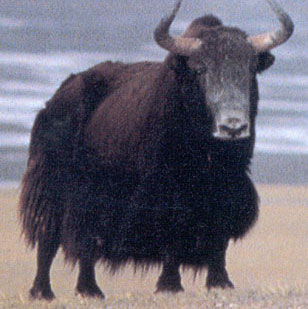drong in Tibetan
The yak symbolises Tibet—and symbolises the romance of the high plateau. Indeed, Tibetan nomads cannot survive without the domesticated yak. It is thought that wild yaks were domesticated by Tibetans many centuries ago. The wild ones are still around in the Chang Thang region and parts of Amdo, but are highly endangered. It is not known how many survive in the wild in Tibet.
In pre-1950 Tibet, wild yaks could be seen in huge herds, often thundering across the grasslands, along with immense herds of kiang (wild asses). In 1939, on a three-month journey from Takster (Amdo) to Lhasa, the chief memory of the four-year-old (future) Dalai Lama was encounters with wildlife along the route: teeming herds of wild yaks, wild asses, Tibetan gazelles and antelopes. These massive herds have all disappeared from the grasslands of Tibet since Chinese invasion. Nomad yak-herders competed with wild yak grazing grounds, but the two groups co-existed (although hybridisation between wild yaks and domestic yaks is a problem). What decimated numbers of wild yaks was the arrival of Chinese soldiers and settlers in the 1960s, who machine-gunned wildlife not only for food, but for export to China—and for sport. Wild yaks were killed by the truck-load. By the late 1970s, the grasslands were eerily empty of wildlife: the wild herds were gone. Tibet's once-plentiful wildlife now faces extinction. The wild yak has gone the way of the bison in North America.
The wild yak is an enormous creature: an adult male can weigh up to 900 kilograms (equivalent to double the weight of a domestic yak), and can stand almost two metres high at the shoulder. Wild yaks mostly graze on grass and herbs. They are sure-footed over rough terrain: herds travel on snow in single file, carefully stepping on footprints left by the lead yak. The wild yak's long shaggy coat enables it to withstand violent winds and snowstorms.
